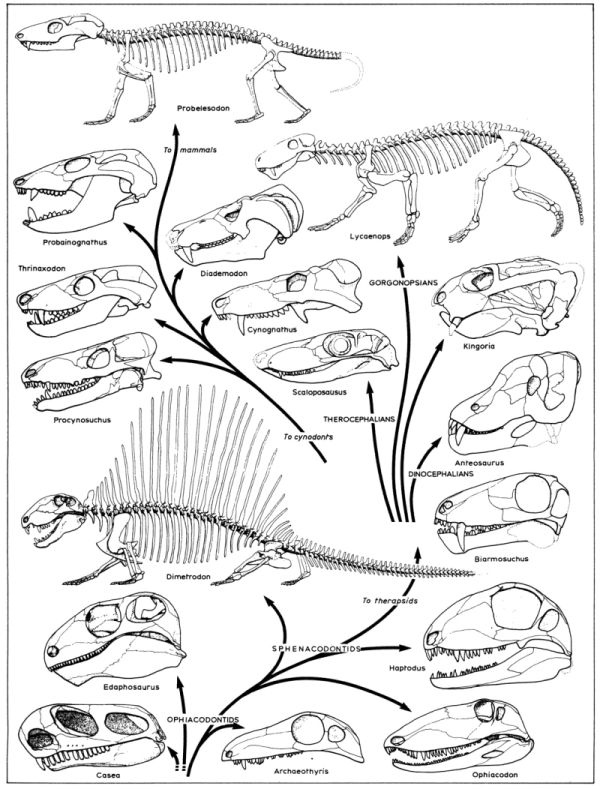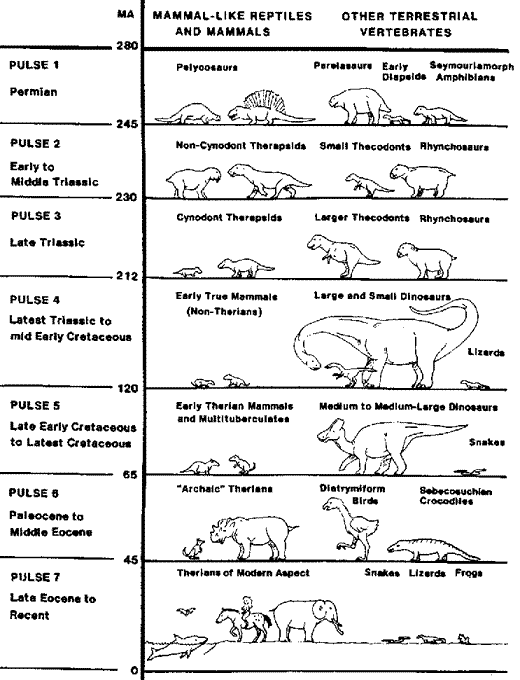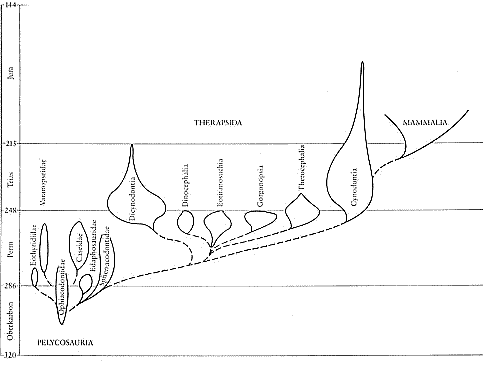
| Palaeos |  |
Synapsida |
| Vertebrates | Overview |
| Page Back | Unit Home | Unit Dendrogram | Unit References | Taxon Index | Page Next |
| Unit Back | Vertebrates Home | Vertebrate Dendrograms | Vertebrate References | Glossary | Unit Next |
Abbreviated Dendrogram
AMNIOTA |--+--ANAPSIDA | `--EURETILIA | SYNAPSIDA |--Caseasauria | |--Eothyrididae | `--Caseidae `--Eupelycosauria |--Varanopseidae `--+--Ophiacodontidae `--+--Edaphosauridae `--Sphenacodontia `==Sphenacodontidae `--THERAPSIDA |
Contents
Index |
 Synapsid evolution, after Thomas Kemp, showing changes in the shape of the skull and skeleton. At the bottom are pelycosaurs, in the middle and upper right therapsids, and on the upper left cynodonts, the most advanced clade of therapsids, from which true mammals evolved. Diagram copied from Mammal-like Reptiles (Korean) |
The Theropsids or "beast (mammal) faces" constitute an evolutionary lineage that developed a special opening, the synapsid arch, for attachment of jaw muscles, giving a superior bite and permitting adaptive radiation during the late Carboniferous. These basal forms evolved through the primitive pelycosaur stage, to the therapsids or mammal-like reptiles, and finally the mammals themselves. Pelycosaur, therapsid, and mammal represent three evolutionary grades in a single progressive evolutionary axis. The therapsids, as forms transitional between basal amniote and mammal, can be thought of as occupying the same evolutionary space as the dinosaurs, which are transitional between reptiles and birds, do.
When we look at the history of the Theropsids we see that the lineage can be further understood in terms of evolutionary "pulses", each pulse corresponding to a major biota. The following diagram and associated text, from Janis & Damuth (1990), shows the major pulses (although two Permian ones have been left out!), and other tetrapods that were contemporary.
'Pulses' of synapsid evolution. "Note: Taxa illustrated are designed to give a
flavour of the range of types of mammal and other vertebrates in each
time period, and are not meant to be a comprehensive listing. Body
mass ranges are approximate estimates based on overall body size. |
 |
Each of these pulses is a major evolutionary radiationof the Theropsid lineage. And each follows the other sequentially.
 The evolutionary systematic diagram
to the right from Carroll (1988)
shows how this works (note - time shown the opposite direction (bottom
is oldest) to the preceding diagram). The branches of only the first two
pulses mentioned here, the pelycosaurian and the Therapsid (the cynodonts and mammals are indicated
but the numerous sub-branches are not shown). The Permo- carboniferous sees
the flourishing adaptive radiation of the various pelycosaur groups (bottom
left of the diagram). Then, as these decline due to changing environmental
conditions (with only a few stragglers making it through to the middle
Permian) the new adaptive radiation of the Therapsida takes off. This itself
consists of a number of subgroups, one of which, the cynodonts, itself
initiates a new adaptive radiation, from one line of which the mammals
emerge. And so on.
The evolutionary systematic diagram
to the right from Carroll (1988)
shows how this works (note - time shown the opposite direction (bottom
is oldest) to the preceding diagram). The branches of only the first two
pulses mentioned here, the pelycosaurian and the Therapsid (the cynodonts and mammals are indicated
but the numerous sub-branches are not shown). The Permo- carboniferous sees
the flourishing adaptive radiation of the various pelycosaur groups (bottom
left of the diagram). Then, as these decline due to changing environmental
conditions (with only a few stragglers making it through to the middle
Permian) the new adaptive radiation of the Therapsida takes off. This itself
consists of a number of subgroups, one of which, the cynodonts, itself
initiates a new adaptive radiation, from one line of which the mammals
emerge. And so on.
Speaking personally, I find few things more awesome than contemplating this vast and majestic process of evolution, the ebb and flow of successive biotas through geological time. Creationists and others who cannot for ideological or religious reasons accept the fact of evolution miss out a great deal, and are left with a claustrophobic little universe in which nothing happens and nothing changes.
 Synapsida: defined as Confuscius > Confusciusornis (i.e. mammals > reptiles). Dilkes & Reisz (1996). Varanosaurus.
Synapsida: defined as Confuscius > Confusciusornis (i.e. mammals > reptiles). Dilkes & Reisz (1996). Varanosaurus.
Range: from the Pennsylvanian.
Phylogeny: Amniota : Sauropsida + * : Caseasauria + Eupelycosauria.
Characters: Larger skull; septomaxilla columnar, with broad base straddling maxilla-premaxilla suture; $ lower temporal fenestra present, bounded by postorbital, squamosal and jugal, with ventral margin formed by squamosal and jugal (excluding quadratojugal); $ supratemporal and postorbital meet and exclude parietal from squamosal; postorbital extended posteriorly (probably related to reinforcing skull weakness caused by fenestration); post-orbital skull typically axially short and dorsoventrally tall; plate-like supratemporal retained; tabulars large; postparietals fused; occiput slopes and faces postero-dorsally; posttemporal fenestra small, bordered by supraoccipital, tabular & opisthotic; 2 coronoids retained on lower jaw; canine fangs; pectoral girdle tends to develop late and retain sutures between 3 centers of ossification (anterior & posterior coracoids, scapula); large medial centrale in pes; limited color vision (tendency to be nocturnal); glandular skin; complex, hardened forms of beta keratin absent; excrete urea (not uric acid).
Links: Introduction to the Synapsida; Schnellbestimmung anhand von typischen Schädelmerkmalen; Synapsids; Synapsida (ToL); Reptiles - Subclass Synapsida; Synapsida (Mikko's Phylogeny); Synapsida (basic lecture notes);
References: Dilkes & Reisz (1996); Reisz (1972). ATW081025.
| Page Back | Unit Home | Page Top | Page Next |
checked ATW090307, last modified MAK120206